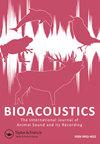A new putative species in the Ectatomma ruidum complex (Formicidae: Ectatomminae) produces a species-specific distress call
IF 2.1
4区 生物学
Q2 ZOOLOGY
Bioacoustics-The International Journal of Animal Sound and Its Recording
Pub Date : 2021-06-11
DOI:10.1080/09524622.2021.1938226
引用次数: 3
Abstract
ABSTRACT Social insects communicate by using chemical, visual, tactile, and acoustic signals, including stridulations. Ectatomma ruidum is a mainly Neotropical ant species complex that has faced strong divergence at the genetic level; the species have a highly variable blend of cuticular hydrocarbons and a relatively conserved morphology. Based on evidence for genetic and chemical differentiation, we tested for variation in acoustic traits. We compared the stridulations produced by the species E. ruidum sp. 2, sp. 3–4 and the new putative species E. ruidum sp. 5, as well as the morphology of the stridulatory file. We found that the stridulations produced by E. ruidum sp. 5 were statistically different from those of the other species in a number of traits. The differences in stridulatory traits might rely more on the way the ants produce the sound (rubbed area percentages) than on the morphology of the stridulatory file, for which we did not find variation. Our results highlight the use of acoustic traits as potential taxonomic tools for integrative taxonomic studies and suggest that the acoustic traits of E. ruidum species complex have been subjected to selection.一种新的推测的物种,在ectomma ruidum复合体(蚁科:ectomatomminae)产生一种特定的求救呼叫
群居昆虫通过化学、视觉、触觉和声学信号进行交流,包括鸣叫。Ectatomma ruidum是一种主要的新热带蚂蚁群落,在基因水平上面临着强烈的分歧;该物种具有高度可变的表皮碳氢化合物混合物和相对保守的形态。基于遗传和化学分化的证据,我们测试了声学性状的变异。我们比较了E.ruidum sp.2、sp.3-4和新推定物种E.ruidumsp.5产生的刺耳声,以及刺耳声档案的形态。我们发现,ruidum sp.5产生的刺耳声在许多性状上与其他物种的刺耳声有统计学差异。尖锐特征的差异可能更多地取决于蚂蚁发出声音的方式(摩擦面积百分比),而不是尖锐锉的形态,我们没有发现它们的变化。我们的研究结果强调了声学特征作为综合分类学研究的潜在分类学工具的用途,并表明ruidum物种复合体的声学特征已经过筛选。
本文章由计算机程序翻译,如有差异,请以英文原文为准。
求助全文
约1分钟内获得全文
求助全文
来源期刊
CiteScore
4.50
自引率
0.00%
发文量
25
审稿时长
>12 weeks
期刊介绍:
Bioacoustics primarily publishes high-quality original research papers and reviews on sound communication in birds, mammals, amphibians, reptiles, fish, insects and other invertebrates, including the following topics :
-Communication and related behaviour-
Sound production-
Hearing-
Ontogeny and learning-
Bioacoustics in taxonomy and systematics-
Impacts of noise-
Bioacoustics in environmental monitoring-
Identification techniques and applications-
Recording and analysis-
Equipment and techniques-
Ultrasound and infrasound-
Underwater sound-
Bioacoustical sound structures, patterns, variation and repertoires

 求助内容:
求助内容: 应助结果提醒方式:
应助结果提醒方式:


